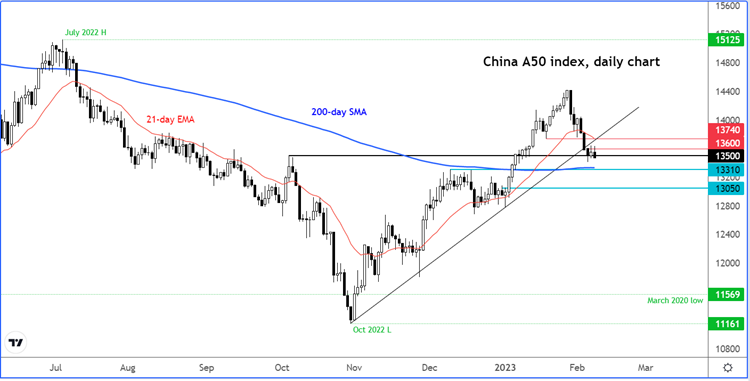Thoughts For Thursday: Risk-Off, Risk-On
The one foot forward, one foot backward action continues on Wall Street, though yesterday it was more like three or four steps backward. It seems Q1 earnings jitters are partly responsible for Wednesday's pull-back.

The S&P 500 ended the day at 4,118, down 1.1% or 46 points, the Dow closed at 33,949, down 0.6% or 208 points, while the Nasdaq Composite finished at 11,911, down 1.7% or 203 points. Risk-off.

Chart: The New York Times
In morning futures trading S&P 500 market futures are up 33 points, Dow market futures are trading up 234 points and Nasdaq 100 market futures are trading up 144 points. Risk-on.
In a TalkMarkets Editor's Choice column contributor James Picerno writes that Early US GDP Nowcasts For Q1 Are Wide-Ranging.
"Depending on the source, the preliminary estimates for US economic activity in this year’s first quarter are encouraging, mediocre, or distinctly bearish...The median estimate for Q1 is zero (seasonally adjusted annual rate). That marks a worrisome slowdown from Q4’s solid 2.9% increase, which marked a second quarter of healthy growth."

"The main source of optimism at the moment is the labor market. The surprisingly sharp gain in US payrolls in January suggests that the economy will continue to expand at a healthy pace...Meanwhile, the S&P US Composite PMI, a survey-based GDP proxy, reflects an economic contraction in January. “Business activity in the vast US services economy contracted in January as companies reported a further deterioration in new business inflows,” says Chris Williamson, Chief Business Economist at S&P Global Market Intelligence."
"The acute mismatch in indicators and GDP nowcasts suggests developing a high-confidence read on the economy remains unusually difficult. Clarity is coming, for good or ill, in the coming weeks as new numbers are published. But at the moment there’s plenty of room for debate on how 2023 is unfolding."
Contributor Timothy Taylor looks at historical data in his column, Hard And Soft Landings: The Federal Reserve’s Record.
"When the Federal Reserve raises interest rates to fight inflation, a “hard landing” refers to the possibility is that inflation is reduced at the cost of a significant recession, while a “soft landing” refers to the possibility that inflation is reduced with only a minor recession–or perhaps even no recession at all...
What is the historical record of the Federal Reserve in raising interest rates and managing a soft landing? Alan S. Blinder tackles that question in the just-published Winter 2023 issue of the Journal of Economic Perspectives in “Landings, Soft and Hard: The Federal Reserve, 1965–2022.”
From Blinder’s paper, here’s a figure showing the federal fund interest rate over time. There are some challenges in interpreting the figure when there are jagged jumps up and down in a short time, but Blinder argues that it is fair to read the historical record as involving 11 episodes where the Fed raised interest rates substantially since 1965."

"What jumps out from the figure is that there are a number of times where the Fed raised interest rates and either it was not followed by a recession (1, 6, and 8), or the recession was very short (9), or the recession that followed was not caused by the higher interest rates (10 and 11). The Fed raising interest rates to nip inflation in the bud in 1994 (episode 8) is perhaps the best-known example of a landing so soft that a recession didn’t even occur. As another example, the Fed was gradually raising interest rates in the lead-up to the pandemic (episode 11), but the pandemic recession was clearly not caused by higher interest rates!
Here’s a table showing Blinder’s evaluation of the type of landing that followed each of the 11 episodes of monetary tightening."

"My own sense, for what it’s worth, is that the US economy is unlikely to escape this episode of higher Federal Reserve interest rates without experiencing a recession, by which I mean a period of higher unemployment and lower production. It seems to me that the pressures and tensions unleashed by the higher interest rates are working their way into reduced borrowing and credit, as well as tensions in bond markets."
Interesting stuff, indeed. See the full article for additional data and insight.
TM contributor Patrick Munnelly finds some good news across the pond finding European Markets On The Front Foot, As German Inflation Increases At A Slower Rate.

"...as delayed German inflation data came in at a lower rate than expected, markets immediately repriced ECB rate hikes as investors price a lower net Eurozone CPI estimate for January at circa 8.5%. Robust earnings from European stalwarts such as Siemens and Unilever along with takeover chatter as Abu Dhabi Bank are reported to be eyeing a bid for Standard Chartered Bank, all in all, this has investors in buoyant spirits at the opening of European trade...
Last week the BoE voted to raise interest rates for the 10th consecutive time by 50bp to 4%, however, the market read was of a more dovish tilt to proceedings, given Governor Bailey’s less than committal stance on further policy tightening, today’s hearing (in the House of Commons) will give committee members a platform to provide color on this and to address any market misperceptions they might feel to be in the reaction to their latest rate adjustment and outlook."
In Asian markets contributor Fawad Razaqzada says Struggling Chinese Equities Calls For Caution.
"Last year, we saw China lead the global markets lower. The fact that equities at the world’s second-largest economy are falling again, this calls for caution for investors around the world. When China sneezes, the rest of the world tends to catch a cold. That said, it is not yet clear whether Chinese equities are simply in consolidation mode after their impressive recent gains, or it is something more significant. I would err on the side of caution, regardless, even if we have seen Chinese data respond positively to the re-opening.
Anyway, here’s a daily chart of our China A50 index, derived from the underlying FTSE China A50 Index (Feb. 8):

"As can be seen from the chart, the index has been trending lower for the last couple of weeks, after the rally on re-opening optimism faded. The index has lost more than 6% from its high last week."
However in Chinese risk-off, risk-on action the Hang Seng Index closed at 21,624 today, up 1.6% or 341 points. ![]()
In today's "Where to Invest Department" contributor Avisol Capital Partners asks NeurAxis: Should You Buy This IPO?, and contributor Moon Kill Woong, takes a deep dive into the NeurAxis IPO as well.
The company which will trade under the ticker (NRXS) is slated to go public today, (Feb. 9) with an initial share price in the $7-$9 range.

"NeurAxis, Inc., a developer of neurostimulation treatments for irritable bowel syndrome and other health conditions, has proposed an Initial Public Offering (IPO) of $15mn through an amended registration document (S-1/A)...In its pre-IPO stage, the company received $28.4mn in investments from investors including Masimo Corporation (MASI) and Brian Hannasch. The company is based out of Carmel, Indiana, and is led by CEO Brian Carrico...The company has 16 full-time employees and one part-time employee.
The company intends to sell 1,875,000 common shares...for a total value of between $13mn and $17mn, respectively. Alexander Capital is the sole underwriter...
NeurAxis develops neuromodulator therapies in a pediatric population suffering from chronic diseases. Lead product is IB-Stim, which has been cleared by the FDA for treating functional abdominal pain in IBS patients, as a non-implanted nerve stimulator device. For the nine-month period ended September 30, 2022, the company had revenues of $2mn. The company targets 260 children’s hospital and has sold its device to 50 of them...
Major competitive vendors that provide or are developing related treatments include the following public companies: Abbvie (ABBV), Bristol-Myers Squibb (BMY), Amgen (AMGN), Arena Pharmaceuticals (ARNA), Gilead Sciences (GILD), Pfizer (PFE), Takeda Pharmaceuticals (TAK).
If they (NeurAxis) can generate some funding through the IPO, they will be able to bring other approvals of the same product to the market. There are four such indications in the pipeline, and each indication is worth at least as much as the current revenue stream of $2mn, probably more with greater exposure."
"This company has a good innovative product and is in a market that is set to grow regardless of what the upcoming two years will reveal. There are indications that FDA approval will occur, however, there are no guarantees. There is only the clear need for their product in the market and people working hard to make it so."
Above are excerpts from the full article which contains a more in-depth company profile.
As always, caveat emptor; even more so regarding an IPO.
Have a good one and remember people in the earthquake-struck regions of Turkey and Syria need your help!
More By This Author:
Tuesday Talk: Risk-on, Risk-off
Tuesday Talk: Too Hot, Too Fast?



